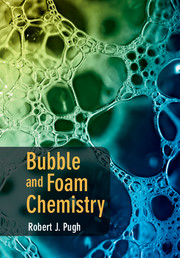Book contents
- Frontmatter
- Contents
- Preface
- Acknowledgments
- List of symbols
- 1 Basic principles and concepts
- 2 The nature and properties of foaming surfactants
- 3 Soap bubbles and thin films
- 4 Processes in foaming
- 5 Generation of bubbles and foams
- 6 Coalescence of bubbles in surfactant solutions
- 7 The stability/instability of bubbles and foams
- 8 Particle-stabilized foams
- 9 Foaming in non-aqueous liquids
- 10 Antifoaming and defoaming
- 11 Bubble size measurements and foam test methods
- 12 Bubble and foam chemistry - new areas of foam research
- Index
- References
8 - Particle-stabilized foams
Published online by Cambridge University Press: 05 September 2016
- Frontmatter
- Contents
- Preface
- Acknowledgments
- List of symbols
- 1 Basic principles and concepts
- 2 The nature and properties of foaming surfactants
- 3 Soap bubbles and thin films
- 4 Processes in foaming
- 5 Generation of bubbles and foams
- 6 Coalescence of bubbles in surfactant solutions
- 7 The stability/instability of bubbles and foams
- 8 Particle-stabilized foams
- 9 Foaming in non-aqueous liquids
- 10 Antifoaming and defoaming
- 11 Bubble size measurements and foam test methods
- 12 Bubble and foam chemistry - new areas of foam research
- Index
- References
Summary
These motions were such as to satisfy me, after frequently repeated observation, that they arose neither from currents in the fluid, nor from its gradual evaporation, but belonged to the particle itself.
“Microscopical Observations on the Particles Contained in the Pollen of Plants,” by Robert Brown, Philosophical Magazine, NS 4, 162–3, 1828.
Introduction
Partially hydrophobic small particles have the potential to act as stabilizing agents in many foaming processes, and they behave fairly similar in some ways to chemical surfactant molecules in that they can adsorb (attach) at the bubble interface. However, particles show several distinct differences from chemical surfactants. For example, macro-sized particles are considerably larger than the molecular dimensions exhibited by chemical surfactants. They also behave differently, in that particles cannot aggregate at the interface and are unable to buildup self-assembles and cannot solubilize in the bulk solution. Unlike chemical surfactants, it is difficult to generate bubbles or foams solely without particles, but partially hydrophobic particles can be good foam stabilizers at moderate concentrations (about 1 w%). In fact, if the particles exhibit moderate hydrophobicity, then the foams can be extremely stable (with lifetimes of the order of years). However, generally it is more convenient to add other surface-active components to the particles, such as polymers, dispersants or chemical surfactants, to ensure a higher degree of foamability and foam stability. The different features exhibited by surfactant- and particle-stabilized systems are illustrated in Fig. 8.1.
There are only a few foaming processes operating solely with particles, for example, molten metal foams (where ceramic particles are used) and sometimes hydrophobic particles (such as graphite) in the froth flotation process. Excluding the past two decades, the literature on foams stabilized by particles is sparse, but there has been a revival of attention, which was mostly because of the success achieved with particle-stabilized emulsions (Pickering emulsions). For a considerable period of time it has been well known that particles acted as stabilizers in many established industrial foaming processes, such as froth flotation of mineral particles (1), deinking flotation (2) and food processing (3). However, little effort was made to understand the mechanisms until recent years; today a considerable amount of insight has been achieved in understanding the basics.
- Type
- Chapter
- Information
- Bubble and Foam Chemistry , pp. 269 - 306Publisher: Cambridge University PressPrint publication year: 2016
References
- 2
- Cited by

